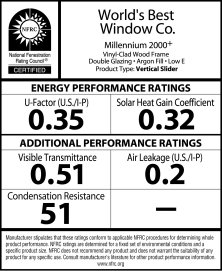 There are a number of ways for consumers to determine the efficiency of window replacements. The National Fenestration Rating Council (NFRC), a non-profit organization that administers uniform and independent rating and labeling system for the energy performance of windows and others home attachment products; have created an NFRC label for all window products that meets the NFRC standard. The NFRC label gives rating for a number of factors including U-factor, Solar Heat Gain Coefficient (SHGC), Visible Transmittance (VT), Air Leakage (AL) and Condensation Resistance (CR). Here we provide an overview of these key window performance measurement:
There are a number of ways for consumers to determine the efficiency of window replacements. The National Fenestration Rating Council (NFRC), a non-profit organization that administers uniform and independent rating and labeling system for the energy performance of windows and others home attachment products; have created an NFRC label for all window products that meets the NFRC standard. The NFRC label gives rating for a number of factors including U-factor, Solar Heat Gain Coefficient (SHGC), Visible Transmittance (VT), Air Leakage (AL) and Condensation Resistance (CR). Here we provide an overview of these key window performance measurement:
U-factor (U-value) – U-factor or U-value measures the rate of heat loss of a window replacement. It is better to have a low rating U-factor as it provide greater resistance to heat flow and therefore better insulation.
Solar Heat Gain Coefficient (SHGC) – SHGC measures the amount of incident solar radiation admitted through a window. Usually measured between 0 and 1, it is better to choose windows with a low SHGC as it transmit less solar heat into your home.
Visible Transmittance (VT) – VT measures the amount of visible light transmitted through the window. It is better to choose a window replacement with a higher VT as it allow more lighting or maximize daylight into the home.
Air Leakage (AL) – AL measures the amount of air passing of a window. It is better to choose window replacements with a lower AL as less air will pass through cracks in the window assembly and provide better insulation for your home.
Condensation Resistance (CR) – CR measures how well a window resist the formation of condensation on the window. Usually measured between 1 to 100, the higher the CR the better the window replacement is able to resist condensation and provide better window view.
Source: http://www.efficientwindows.org/performance.php
By: Paul Doh
